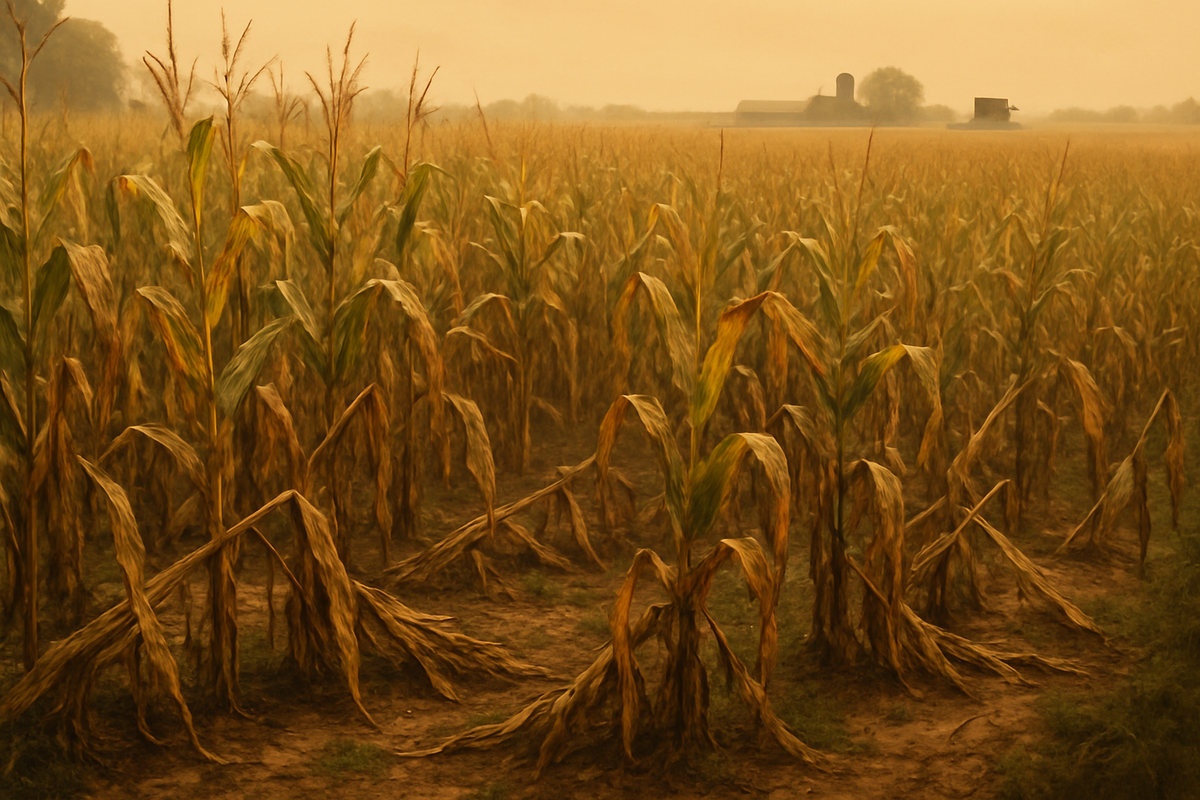
Illinois's vital corn crop is facing a critical juncture as the 2025 harvest season unfolds, with agronomists issuing stern warnings about widespread stalk deterioration. A punishing combination of prolonged heat stress and aggressive disease pressure throughout the growing season has severely compromised plant integrity, raising significant concerns about harvest efficiency, potential yield losses, and the financial viability for many producers. This alarming development threatens to exacerbate an already challenging market environment, potentially impacting regional corn supply and further squeezing farmer margins amidst a global backdrop of robust production.
The immediate implications are profound for Illinois farmers grappling with weakened stalks prone to lodging, which complicates harvesting and increases field losses. While global corn supplies are projected to remain abundant, the localized issues in a key agricultural state like Illinois could create regional supply tightening and underscore the fragility of agricultural yields in the face of climate volatility and escalating disease threats. The situation is particularly dire given current market prices that are well below the breakeven point for many producers, turning what should be a period of bounty into one of deep financial concern.
Unpacking the Crisis: Heat, Humidity, and a Barrage of Diseases
The genesis of the current crisis can be traced back to a relentless "heat dome" that settled over the Midwest during July 2025, subjecting Illinois cornfields to weeks of intense heat and, in some northern regions, localized drought. These extreme conditions not only hindered pollination, leading to "tip back" on corn ears, but also accelerated crop maturation as elevated nighttime temperatures in August rapidly accumulated Growing Degree Units (GDUs). This environmental stress laid the groundwork for a subsequent onslaught of fungal diseases, which found ideal conditions in the hot and humid climate.
Agronomists confirmed the early arrival of several aggressive diseases in northern Illinois by July, with a rapid proliferation throughout the state in the following months. Tar Spot (caused by Phyllachora maydis) was particularly prevalent, confirmed in numerous northern counties including DeKalb, Kane, McHenry, and Lake, with 22 Illinois counties reporting cases by September. Southern Rust (caused by Puccinia polysora) was also detected early, benefiting from favorable August conditions and winds from the south. Other significant threats included Gray Leaf Spot (caused by Cercospora zeae-maydis), Northern Corn Leaf Blight (caused by Exserohilum turcicum), and Anthracnose Stalk Rot (caused by Colletotrichum graminicola). Fields that did not receive timely fungicide treatments were particularly vulnerable to these pervasive pathogens.
Matt Montgomery, an agronomy education lead, highlighted the insidious nature of these diseases in late September 2025. When fungal infections damage corn leaves, the plant's natural response is to "cannibalize" its own stalk to heal the compromised tissue. This process critically weakens the stalk, making plants highly susceptible to lodging—falling over before or during harvest. The combination of significant rainfall and disease pressure this season has amplified the risk of stalk rot, especially as diseases in the upper canopy force the ear to draw more sugars from the lower stalk, further compromising its structural integrity. Farmers were advised to conduct "push tests" to identify at-risk fields and prioritize their harvest to mitigate losses.
Corporate Crossroads: Who Wins and Loses in a Challenged Corn Market
The widespread stalk deterioration and potential yield reductions in Illinois are poised to create a ripple effect across the agricultural supply chain, affecting a range of public companies. Companies involved in agricultural inputs, grain handling, food processing, and ethanol production could all see significant impacts, though not always negatively.
Agricultural input providers, particularly those specializing in fungicides and crop protection, might see a mixed bag. While the 2025 season saw increased demand for fungicides in affected areas, the overall financial strain on farmers due to low commodity prices and potential yield losses could temper future input purchases. Companies like Corteva Agriscience (NYSE: CTVA), BASF (FWB: BAS), and Bayer AG (FWB: BAYN), which offer a broad spectrum of crop protection products, may experience a slight uptick in demand for specific disease-resistant seed varieties or targeted fungicide applications in future seasons, as farmers seek to prevent a recurrence. However, if farmer profitability remains depressed, it could lead to reduced spending on higher-margin products.
Grain handlers and processors, such as Archer-Daniels-Midland Company (NYSE: ADM) and Bunge Global SA (NYSE: BG), could face challenges related to the quality and quantity of corn available from the affected regions. Increased lodging and harvest losses mean less corn reaching elevators, potentially increasing procurement costs or requiring them to source from further afield. While global supplies are abundant, localized quality issues could necessitate adjustments in their processing operations. Conversely, if the overall U.S. harvest remains strong despite Illinois's issues, these companies may benefit from lower overall commodity prices, provided they can secure sufficient quality grain. Ethanol producers, like Green Plains Inc. (NASDAQ: GPRE), are also highly dependent on corn supply and price. Reduced regional availability or higher local prices due to quality issues could impact their margins, though the broader low price environment for corn might offer some relief.
Broader Implications: Climate Volatility, Food Security, and Market Realignments
The challenges faced by the Illinois corn crop in 2025 serve as a stark reminder of agriculture's increasing vulnerability to climate volatility and evolving disease pressures, fitting into a broader trend of unpredictable weather patterns impacting global food systems. The "heat dome" and subsequent humid conditions are consistent with climate change projections that anticipate more frequent and intense extreme weather events, which can stress crops and create ideal environments for pathogens. This event underscores the urgent need for resilient agricultural practices, including diversified crop rotations, improved soil health, and the development of more robust, disease-resistant crop varieties.
The ripple effects extend beyond direct agricultural players. Food security, particularly regarding corn-derived products, could see minor localized impacts, though the USDA's projection of abundant global supplies should buffer any widespread shortages. However, the event highlights the fragility of regional supply chains. Competitors in other corn-producing states or countries that experienced more favorable growing conditions might see a relative advantage, potentially shifting trade flows. Furthermore, the financial strain on Illinois farmers could lead to increased demand for crop insurance, impacting providers like Chubb Limited (NYSE: CB) or American Financial Group, Inc. (NYSE: AFG) and potentially influencing future agricultural policy discussions around federal support programs.
Historically, periods of severe weather combined with disease outbreaks have led to significant market shifts. For example, the widespread drought of 2012 caused corn prices to surge. While the 2025 situation is different due to the global supply context, it draws parallels in demonstrating how localized agricultural setbacks can still create regional economic distress and highlight systemic vulnerabilities. The emphasis on stalk integrity and disease management will likely become even more critical for farmers and agricultural research institutions, driving innovation in both seed technology and agronomic practices.
The Road Ahead: Navigating Uncertainty in the Corn Market
Looking ahead, the immediate focus for Illinois farmers will be on completing the 2025 corn harvest as efficiently as possible, prioritizing fields with severe standability concerns to minimize further losses. This may involve adjusting harvest schedules and equipment, potentially leading to increased operational costs. In the short term, the market will closely monitor actual yield reports from Illinois and other key corn-producing states, which will provide a clearer picture of the overall U.S. supply. Any significant downward revisions to USDA yield estimates could introduce upward volatility to corn prices, though the current global surplus suggests a limited impact on the broader market.
For the long term, the challenges of 2025 will likely prompt strategic pivots among farmers and agricultural companies. Farmers may increasingly invest in disease-resistant seed traits, enhanced scouting technologies, and more proactive fungicide application strategies. Research and development in agricultural biotechnology, championed by companies like Bayer AG (FWB: BAYN) and Corteva Agriscience (NYSE: CTVA), will likely accelerate to develop corn varieties better equipped to withstand extreme heat and a broader spectrum of pathogens. The market opportunities may emerge for precision agriculture technologies that help identify and manage crop stress more effectively.
Potential scenarios range from a continued low-price environment, further squeezing farmer profitability into 2026, to a moderate price recovery if global demand strengthens or if future growing seasons face similar widespread challenges. Investors should watch for changes in USDA crop progress reports, global demand indicators (especially from major importers like China), and any shifts in input costs, such as the projected slight increase in fertilizer prices for 2026. The resilience of the agricultural sector will be tested, requiring adaptability and innovation to navigate these evolving environmental and economic pressures.
Concluding Thoughts: A Bellwether for Future Agricultural Challenges
The 2025 Illinois corn crop crisis, marked by severe stalk deterioration due to heat and disease, serves as a significant bellwether for the future of agriculture. It underscores the intertwined challenges of climate change, evolving pathogen threats, and the persistent pressure on farmer profitability. While global corn supplies are currently robust, the localized difficulties highlight the critical importance of regional agricultural health and the potential for severe financial hardship at the farm level, even when broader market conditions appear stable.
Moving forward, the market will continue to grapple with the delicate balance between supply and demand, influenced heavily by weather patterns, disease outbreaks, and macroeconomic factors. Investors should pay close attention to agricultural commodity futures, the performance of key agricultural input and processing companies, and the ongoing development of climate-resilient farming technologies. The events of 2025 in Illinois are a powerful reminder that agricultural success is never guaranteed and that vigilance, innovation, and strategic adaptation will be paramount for sustaining food production and supporting the livelihoods of those who feed the world.
This content is intended for informational purposes only and is not financial advice







